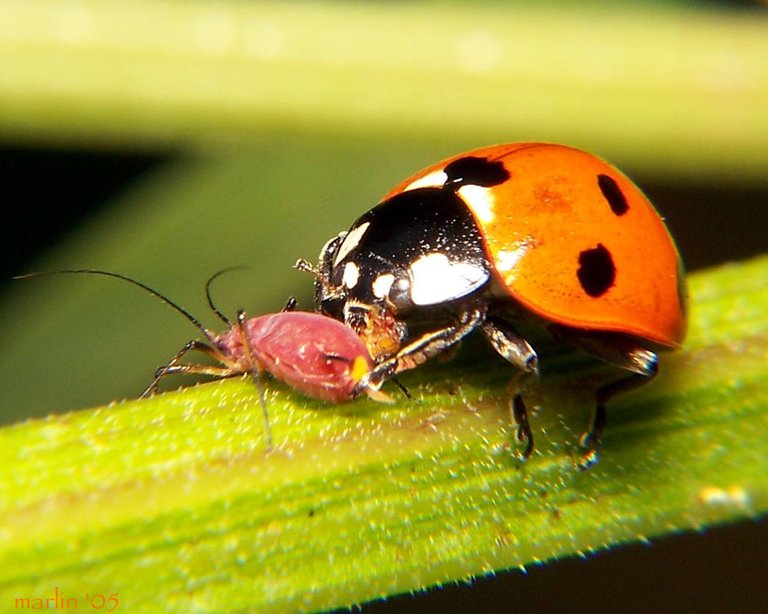
I think that practically all those who have or have had plants at home have ever suffered the attack of these small "suckers", capable of ending a healthy plant in a matter of weeks if the necessary measures are not taken.
And although there are many measures to alleviate or eliminate these Hemiptera, which I will also mention in a nutshell, today we will focus on one of our protagonists.
Because we have a close and voracious ally that will help us in a natural way to fight these little ones.

Let's start by talking a bit about the aphid in broad strokes.
These small creatures, approximately 3 millimeters in length, usually attack our plants between Spring and Summer.
They feed by biting the plant and sucking its precious sap.

Not only do they dry the plant and prevent its photosynthesis, but also transmit a virus to every plant they bite.
In this regard, winged females are responsible for transmitting the pest to nearby plants.
Their reproduction is exponential, since the females can give birth to new females without having to be mated by males and also these newborns are created already perfectly formed (they do not lay eggs).

There are about 500 species of aphids, including the green aphid, like the one in the picture.
All species feel a predilection for new and more tender buds although depending on the species, some focus on one type of plant only and other aphid species have a wider range in choosing the type of plants to feed.

And here I present you formally to our small and colorful heroine of garden, a coleopteran of the family of Coccinellidae.
Our friends have precisely the instinct to lay their eggs near the colonies of aphids and, because they are winged, they can also follow the winged females of the aphids to any other plant, so that they may also create another anti-aphids settlement there.

One week after laying the eggs hatch the larvae of the ladybirds.
These larvae are capable of eating between 50 and 150 aphids per day.
A figure that is not negligible but if we consider that a single female of aphids can create, throughout its life, a million aphids, does not seem so much, right?
These larvae go through 4 different states before forming the chrysalis and becoming a ladybug.
The adult ladybug has a 1 year mean of life and depredates about 80 aphids a day, a figure that is not bad either.
In the absence of aphids our colorful heroines can feed temporarily on nectar of flowers and pollen, so it is in our garden's interest to have some striking flower to attract and keep them close.

However our friends also have their own predators, such as: birds, frogs, wasps, spiders and dragonflies.
Although it seems that one of the natural defenses of our ladybug is its bad taste in the mouth of its predators.
Other ways to end the aphid can be:
- Spray the affected parts with water under pressure; remember that the sooner you act on the colony the easier it will be to finish them off.
- Potassium soap at 2% every two weeks and with a minimum of 3 applications.
- Neem oil, an ecological alternative that also fights other types of pests besides the aphid.
- Systemic insecticide with dimethoate in its composition.
Sources/Fuentes
http://articulos.infojardin.com/PLAGAS_Y_ENF/PLAGAS/Pulgones.htm
http://www.joseeljardinero.com/eliminar-pulgon-plantas/
https://es.wikipedia.org/wiki/Coccinellidae
http://www.unhuertoenmibalcon.com/blog/2015/03/mariquitas-insecticida-natural-pulgones/
Amazing closeups! +1
Indeed! :P
Thank you very much for this nice article.
You're welcome man! I hope you've enjoyed reading it!
wow i didnt know lady bugs can be this useful!
It was an amazing discover to me also. Every creature have their purposes in life! :)
You post is very helpful for those who enjoy gardening. Unfortunately I don't have a green thumb.
Gardeners or those who have flower pots will really like it but I hope this info will usefull by itself for those who like to know some new curious nature facts :)
I once read that ladybugs become cannibals with a lack of other food...
I didn't read about this info. Have you contrasted it? It's a very interesting fact to search about.
I don't know if you watch TPB (Trailer Park Boys), I know, random... But they had an episode where pests were fought with lady bugs, it was both entertaining and informative:)
I didn't know about the existence of that TV show to wich you refer. I think itsn't broadcasted in my country.
But sure ladybugs do their gluttonous work :)
OH waw ! muy IMPRECIONANTE ; me facinan . las mariquitas lady bog . waw . esta muy educativo si . primera vez que veo su larvas y sus huevos ; ahora se si veo algo asi en mi jardinera / . Bello Bello Bello ! adoro tu post !!!.
A pleasure!Thank you @eaglezoo777
nice post
wonderful pics
making me enjoy @dresden
Thanks man!
I really like that you've enjoyed that info.
dont forget follow+vote me
i will follow you backyou are welcome @dresden